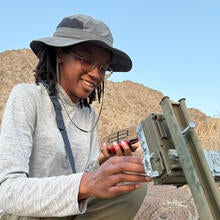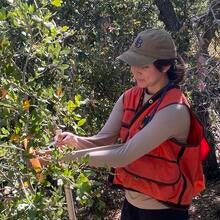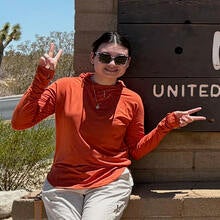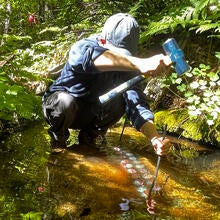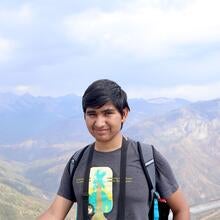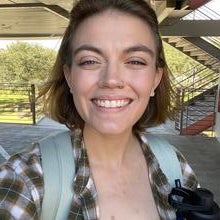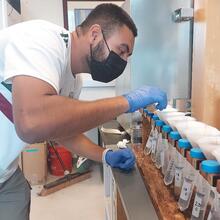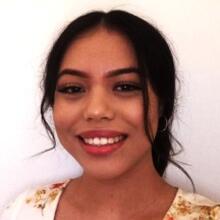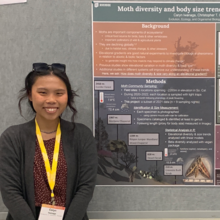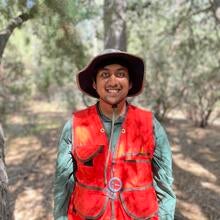The NRS Experiential Internship
started in 2021 with just 3 students and continues to grow. We have just completed our fifth year for the NRS Internship and over this time a total of 38 interns have gained outstanding field-based research experience. As our 5th year in the summer of 2025 comes to a close, we look back on the 13 interns for the Summer 2025 (see photo above) and are amazed at just how much they broadened their horizons as they worked in nature. Over the last five years, the UCR natural reserves have hosted some fantastic students! Each person brings their own unique perspective which has enriched our program. We hope to build a wide network of interns and mentors that continues to interact with the natural reserve system throughout their careers. We look forward to next summer working with the 2026 interns! Come back to this page next summer and see what great interns keep working at UCR! Read below to gain an understanding of just how this internship impacts the students as they continue to investigate all the opportunities that involve nature!
2025
Deanni Armstrong
Over the summer, I worked with Dr. Chris Tracy, Dr. Bill Hoese, and Juniper Graham at the Boyd Deep Canyon Desert Reserve in Palm Springs, California. While working at the reserve, I was responsible for tracking Mojave Desert Tortoises using radio telemetry and maintaining the trail cameras set up at tortoise burrows. My project during the internship focused on organizing the camera footage to understand desert tortoise activity. I also had the opportunity to form new connections by working with the USGS and the Living Desert Zoo, which allowed me to gain hands-on experience with Desert Tortoises in the field. My mentors provided valuable information and shared several opportunities for me after the internship ended. Their encouragement helped me feel more confident about working in my field and applying for grad school. Overall, the experience was incredible and I highly recommend the program to anyone who wants to work in the field and gain invaluable new connections.
Natalie Bonning
I had an amazing time over the summer working with the Spasojevic and Catano labs. At the beginning of the internship, I strived to discover what herbaceous plants were actually growing at the James Reserve and later narrowed this question to: “What percent is each species covering across different types of land?” Working as a team, I learned how to identify herbaceous plants to answer these questions. Alongside the Spasojevic lab, I got to measure and tag new tree seedlings and newly adult trees, core a few trees, and replace camera trap batteries and SD cards at both the Boyd Deep Canyon and the James Reserves. Over the course of the internship, I further developed data cleaning and analysis skills using R and general adaptability to the unforeseen challenges of conducting research. I also met other wonderful interns, lab mates, and graduate students that helped reaffirm my belonging in research and ecology.
Sidney Esparza
This past summer I had the wonderful opportunity of working in the Ostevik lab with graduate student Gangothri to investigate what habitat characteristics might be barriers for Penstemon in Southern California. Through this internship, I was able to explore parts of Southern California I hadn't been to before. From the unforgiving heat of Joshua Tree National Park to the cool forests of San Bernardino National Forest, gathering soil samples, snapping pictures of specimens -- & collecting some for the herbarium collection -- has been a rewarding experience.
Liz Garcia
The NRS summer internship was a life changing experience for me. I worked in the Spasojevic Lab researching pine health on the San Jacinto Forest Dynamics Plot, adjacent to the James reserve. Alongside the head researcher, graduate student Sophie Crehan, I focused on pine reproductive health and got to spend a large part of my time counting pine cones of the four pine species that we have on the plot with my focus being Pinus jeffreyi and Pinus ponderosa. I also assisted the lab in finishing the 2024 census of the main stems on the plot, as well as started and finished the seedling census for our 256 seedling plots. In addition to getting to participate in this amazing field work, I also lived at the James reserve for the summer and had the pleasure of getting to spend time with the new director of the James, Casey Woodall. While there, I got to listen to lectures hosted by local botanists and interface with biologists of all different disciplines. Overall, this internship not only gave me an idea of what my future career could look like as a field researcher, but also showed me just how many opportunities are actually out there for my degree. With the research I did with Spasojevic lab, I am going to help write a paper on our findings and will have a poster of my research at the coming up California Native Plant Society conference. I am truly so thankful to Dr. Kim Hammond, Dr. Diana Weber, Dr. Marko Spasojevic, and Sophie Crehan for this amazing opportunity, and for encouraging my love for ecology and biology.
Juniper Graham
Over the summer, I interned at Boyd Deep Canyon, and it was an amazing opportunity to work with researchers from the reserve and other organizations. At the reserve, there is a population of tortoises that we would track weekly, and cameras we maintained that were aimed at capturing their movement and behavior near their burrows. My project focused on visualizing movement data collected over the years. By using ArcGIS and FieldMaps, I created a map of all known burrows and the corresponding movement data for each tortoise. I gained experience with using those two software programs, and with data management and entry, and video sorting. I enjoyed going out into the field and collecting data, even when the temperatures reached over 100 degrees Fahrenheit. Working with other researchers has given me more insight into other ways of conducting similar research on tortoises. Overall, I am very grateful to have participated in this internship, and I now feel certain that this is the field I would like to pursue.
Olive Levesque
This summer I worked on a variety of projects working mostly with populations of carnivores in the Riverside area with the Armstrong lab. I did a lot of research, learned how to use GIS and other software, analyzed camera trap footage of a wide variety of animals, and used acoustic monitoring to observe bat populations. The biggest way the internship impacted me is by demonstrating that despite the challenges I face there is a place for me in this field, and that no matter what happens there will always be a space and a way for me to do the things I love and make contributions to science while doing so.
Haley McCann
The NRS internship was an experience I will never forget. In the Rankin Lab, I studied plant-insect interactions with weevils, grasshoppers, and yellowjackets. Although I have never taken an entomology or botany class before, I discovered a strong interest in these topics and their role in the natural world. My main project examined how weevils feed on mallows and I compared their survival rates across different species, giving me firsthand insight into ecological relationships. Along the way, I gained practical skills with methods such as LeafByte, mating, and feeding cages. I especially enjoyed my experience of fieldwork where I was able to collect weevils and bees, measuring flower nectar with a refractometer, and analyze different mallows over time. This internship gave me a deeper appreciation for research and the excitement of discovery. This journey not only confirmed my passion for science but also inspired me to pursue a career as a lab specialist. I am very grateful for this opportunity and for everyone who guided and supported me along the way. I already miss working in the lab!
Qui Vo
This internship gave me the opportunity to work in a research lab and build connections with graduate students and mentors, while also opening my eyes to potential career pathways I had never considered before. Over the summer, I worked with the Harms lab, where my research focused on how nutrient limitations affect primary stream algal growth. I visited several sites in Southern California to install monitoring tools in streams and assisted graduate students with data collection. Through this experience, I gained valuable research skills such as data analysis, familiarity with scientific terminology and hands-on experience with lab equipment. I also met many supportive peers and mentors who showed me that I was cared for and never alone in this journey.
2022
Gerardo Avila
This internship has given me the opportunity to work in a research lab for the first time and I learned from my mentors that guided me throughout this summer experience. I spent this summer participating in the monitoring and tracking of desert tortoises at Boyd Deep Canyon Reserve and I had the chance to meet the reserve director and biologists from USGS who have been studying the tortoises for many years! I learned a lot about collaborating with others, especially with the experts, and learned valuable research skills for my future career. Thanks to this internship, I discovered that I want to be involved in field research, and I recommend this program to those who want to explore new career paths.
Gabriela Ferraro
My experience at the UC Riverside NRS was absolutely amazing and truly eye-opening. I worked in the Rafferty Lab with some post-doc students and I was able to help them with their research on diurnal and nocturnal pollinators in a changing climate. I specifically learned a lot about moth diversity and worked in the lab to identify moth species with other undergrad students. I also was able to join lab members out in the field to catch moths using traps and sample them. I also gained knowledge and experience on classifying diurnal insects of different families, pinning insects, and I was also able to actively help catch pollinators during the day and document any necessary data such as the flower that is being pollinated, the time of day, weather, etc.. It was an amazing experience and opportunity being able to contribute to their research and learn so much about pollinators and just how important they are for our ecosystems. I am most grateful for the connections and networking I have been able to make since this internship. I have been introduced into so many future possibilities that can help show me potential career pathways in the environmental biology field. This experience has shown me that I would like to work in this area of study and save our biodiversity and help combat climate change in some way.
Felix Osuna
This internship has given me a different perspective into what the natural world has to offer. It made me realize how much a two month internship can impact your life. Being able to connect with other undergraduate and graduate students gave me a greater understanding into my future and the way I want to shape it. As a transfer student from community college, I feel very prepared to start my first quarter at a university.
Daniela Ramos Rodriguez
Over summer I spent an amazing time at the Woodard lab. The lab is in the entomology department and their main focus is feeding biology and nutritional ecology in bees. The model system they use is bumble bees so I spent the summer learning about bumble bees. I was able to observe multiple species of bumblebee bees. I learned how to safely catch them, feed them, and clean their living environment which depended on the experiment. I was lucky to have such an amazing team of Phd students teaching me many techniques. I learned how to dissect wings, dissect abdomens, and dissect their ovaries and spermatheca. I also learned a bit about nutritional assays and how they are performed. I spent a wonderful time in the field learning about all the different types of flowers they like best and how to spot bumble bees from other moths and animals that look extremely similar. I worked on my patience when catching them since we don’t live in an ideal environment for them, but once we took a trip up to the bay area, they were more easily found since it is the climate they preferred. Overall my experience was amazing and I would do it all over again if I had the opportunity. It definitely gave me a view into what is available for me after I get my bachelor’s degree in biology. It also showed me how fun a lab environment can be which was really great since coming in I was really intimidated by research.
2021
Caryn Iwanaga
I am so grateful for my time as an NRS intern. This was my first independent research experience and it has enabled me to gain valuable skills, create a network of amazing mentors, and launch my own research project. During my time as an intern I enjoyed learning new skills like insect pinning, insect identification, and greenhouse plant preparation. Throughout the summer, I learned about various projects by interacting with lab members and by discussing their research, however, when deciding the topic of my independent project, I was the most excited by moths! My project studied the relationship between moth diversity and moth body size trends along the Boyd Deep Canyon elevation gradient. I was able to sample hundreds of moths, collected by graduate student Chris Cosma, and learn how to identify them as well as develop valuable data management skills. Since the summer, I have continued to sample and manage multiple years worth of data and trained other undergraduates in moth identification. I also presented my preliminary findings at the 2022 Annual ESA Conference in Montreal, Canada.
Advyth Ramachandran
In summer 2021, I was part of the first group of interns of this unique UCR NRS program. I worked with my faculty mentor, Dr. Marko Spasojevic, and graduate student mentor, Jared Huxley, to survey seedlings in the lab’s San Jacinto Forest Dynamics Plot at the UCR James San Jacinto Reserve. We established 256 plots within the 4 ha forest plot within which we tagged, measured, and identified over 500 seedlings. We found that there is little pine recruitment in this mixed evergreen oak-pine forest, which may suggest a change in forest composition under climate change. Through this internship, I have learned numerous research skills including study design and data management. This experience was crucial in encouraging me to pursue my goal of graduate study in ecology.

